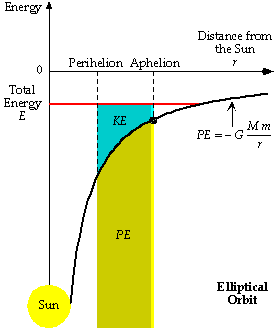Dear Student
Gravitational potential V is defined as the potential energy per unit test mass. Following is the fuller mathematical aspects of the definition.


- 5

We consider the work that an external agent would have to do in moving our mass m from an infinite separation to some separation R from mass M. I find it slightly easier to consider this problem the other way round – what work needs to be done to move the mass m from R to infinity. Because the gravitational force is attractive, separating the masses requires a positive amount of work from the external agent. (Imagine doing the job yourself – if you had to separate masses that were attracted to each other in this way, you yourself would be doing positive work, and would get tired as a result).
Thus, bringing the masses together requires negative work from the external agent. By definition, the work done in moving through the distance ΔX in the diagram above is
![]()
To evaluate the total work done in moving from infinity to a separation R, it is necessary to use integral calculus on the above expression. The result is found to be:
![]()
The expression above, describing the work that has to be done by an external agent in bringing the masses together, is referred to as the gravitational potential energy.
The gravitational potential is then defined as the work that needs to be done by the external agent on a UNIT mass, so that
![]()
Notice that the gravitational potential is only a function of the separation R. In more complex systems, the potential is a more complex function of position.
We will not say more about the theory of gravitational potential, since the maths becomes rather involved in developing the concept further, and in fairness, the maths and the theory has a certain "dryness" to it.
However, it should be noted that the two approaches we have seen so far, namely gravitational force and potential, are alternative but equivalent means of describing the same gravitational field. Sometimes it is convenient to work in terms of gravitational force, sometimes in terms of gravitational potential. In some cases it might be easier to compute the gravitational force, and sometimes it might be easier to compute the potential. The gravitational field strength is related to the gravitational potential through the following differential relationship (in the case of the one-dimensional system above)
![]()
Thus, if the potential can be obtained, so can the gravitational force.
Application - Escape Velocity
An interesting application of gravitational potential and potential energy is to compute the escape velocity of an object from the earth’s surface. That is, the velocity that the object must have to escape completely from the earth’s gravitational field. The gravitational potential energy of an object of mass m at the earth’s surface is given by
![]()
If the object is to escape entirely from the earth’s gravitational field, then it must have an initial kinetic energy that is sufficient to increase its potential energy from this value to zero. If the mass of the earth is M and its radius is R, and the initial velocity of our object is v, then we require that
![]()
With M = 6 1024 kg, R = 6,400,000 m and G = 6.7 10-11 N m2 kg-2, we get v = 11,200 m s-1, which equates to about 7 miles per second. This is the initial velocity that an object at the earth’s surface requires to escape into outer space. (Note that in this calculation, we have neglected air resistance – taking this into account will increase the required escape velocity).
- -1
gravitation potential at any point in the gravitational field of a given mass is defined as the work done in bringing any mass from infinity to that point ..it is denoted by "U" $ U = -GMm/r ( G = Gravitation , M= mass of earth ,m = mass of that object which we hv to bring to gravitatinal feild , r= radius) .................I HOPE U WILL GET DIS :))
- 1


